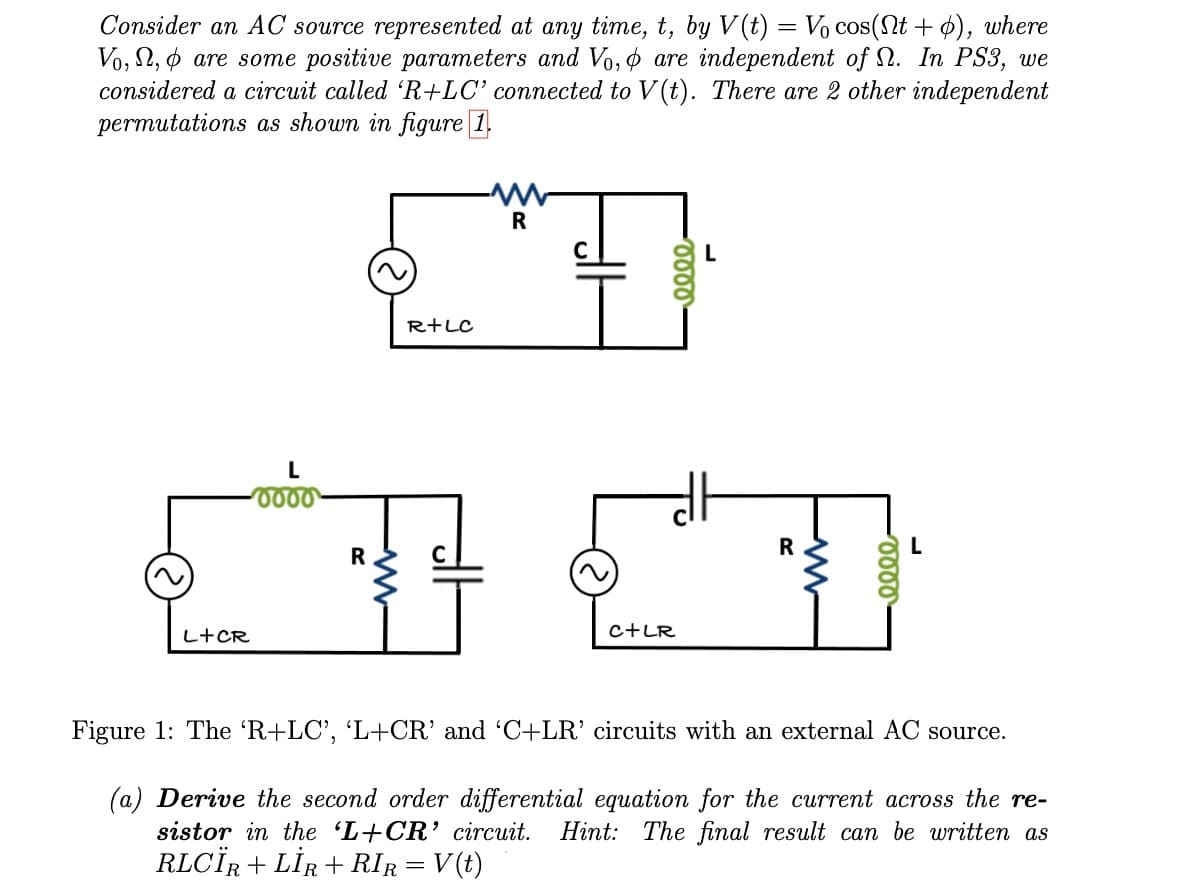Consider an AC source represented at any time, t, by V(t) = Vo cos(nt + o), where Vo, , are some positive parameters and Vo, are independent of . In PS3, we considered a circuit called 'R+LC' connected to V(t). There are 2 other independent permutations as shown in figure 1. L+CR L 0000) R R+LC www R C+LR 0000 R Figure 1: The 'R+LC', 'L+CR' and 'C+LR' circuits with an external AC source. (a) Derive the second order differential equation for the current across the re- sistor in the 'L+CR' circuit. Hint: The final result can be written as RLCÏR + LİR + RIR = V(t)
Consider an AC source represented at any time, t, by V(t) = Vo cos(nt + o), where Vo, , are some positive parameters and Vo, are independent of . In PS3, we considered a circuit called 'R+LC' connected to V(t). There are 2 other independent permutations as shown in figure 1. L+CR L 0000) R R+LC www R C+LR 0000 R Figure 1: The 'R+LC', 'L+CR' and 'C+LR' circuits with an external AC source. (a) Derive the second order differential equation for the current across the re- sistor in the 'L+CR' circuit. Hint: The final result can be written as RLCÏR + LİR + RIR = V(t)
Introductory Circuit Analysis (13th Edition)
13th Edition
ISBN:9780133923605
Author:Robert L. Boylestad
Publisher:Robert L. Boylestad
Chapter1: Introduction
Section: Chapter Questions
Problem 1P: Visit your local library (at school or home) and describe the extent to which it provides literature...
Related questions
Question
help me to do part a please; this is not a graded question

Transcribed Image Text:Consider an AC source represented at any time, t, by V(t) = V₁ cos(Nt+ o), where
Vo, , are some positive parameters and Vo, are independent of . In PS3, we
considered a circuit called 'R+LC' connected to V(t). There are 2 other independent
permutations as shown in figure 1.
L+CR
L
0000
R
R+LC
R
C+LR
0000
R
-0000
L
Figure 1: The 'R+LC', 'L+CR' and 'C+LR' circuits with an external AC source.
(a) Derive the second order differential equation for the current across the re-
sistor in the 'L+CR' circuit. Hint: The final result can be written as
RLCÏR + LİR+RIR = V(t)
Expert Solution
This question has been solved!
Explore an expertly crafted, step-by-step solution for a thorough understanding of key concepts.
This is a popular solution!
Trending now
This is a popular solution!
Step by step
Solved in 4 steps with 17 images

Recommended textbooks for you

Introductory Circuit Analysis (13th Edition)
Electrical Engineering
ISBN:
9780133923605
Author:
Robert L. Boylestad
Publisher:
PEARSON

Delmar's Standard Textbook Of Electricity
Electrical Engineering
ISBN:
9781337900348
Author:
Stephen L. Herman
Publisher:
Cengage Learning

Programmable Logic Controllers
Electrical Engineering
ISBN:
9780073373843
Author:
Frank D. Petruzella
Publisher:
McGraw-Hill Education

Introductory Circuit Analysis (13th Edition)
Electrical Engineering
ISBN:
9780133923605
Author:
Robert L. Boylestad
Publisher:
PEARSON

Delmar's Standard Textbook Of Electricity
Electrical Engineering
ISBN:
9781337900348
Author:
Stephen L. Herman
Publisher:
Cengage Learning

Programmable Logic Controllers
Electrical Engineering
ISBN:
9780073373843
Author:
Frank D. Petruzella
Publisher:
McGraw-Hill Education

Fundamentals of Electric Circuits
Electrical Engineering
ISBN:
9780078028229
Author:
Charles K Alexander, Matthew Sadiku
Publisher:
McGraw-Hill Education

Electric Circuits. (11th Edition)
Electrical Engineering
ISBN:
9780134746968
Author:
James W. Nilsson, Susan Riedel
Publisher:
PEARSON

Engineering Electromagnetics
Electrical Engineering
ISBN:
9780078028151
Author:
Hayt, William H. (william Hart), Jr, BUCK, John A.
Publisher:
Mcgraw-hill Education,